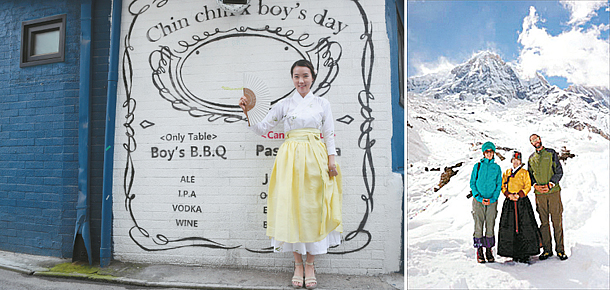Bringing hanbok into the modern world : Kwon Mi-ru travels the globe to introduce Korea’s national dress

Kwon Mi-ru, left, poses in front of a shop in a modern hanbok designed for everyday use. This particular dress has a skirt that can be worn outside the upper garments. Kwon, right, trekking on Annapurna Massif in Nepal. She chose a warmer hanbok. [KIM CHUN-SIK, KWON MI-RU]
Her obsession dates back to 2013 from a discussion on an online forum. “We spontaneously discussed amongst ourselves the topic of wearing traditional clothing within our wardrobes, initially for the purpose of cleaning out our closets. There were lot of different styles at an offline meeting we held. I mostly had yellow upper garments and red skirt combination. I found that there was more to hanbok than I imagined.”
Kwon went in search of new hanbok. She found some innovative styles, notably cheolik design, formal-wear for government officials reimagined by hanbok designer Kim Young-jin. “It started out as a search for dresses to match my own personality. I preferred how I looked in hanbok, and even before that I liked experimenting with clothing. So I dug deeper, and learned about transformation within the traditional hanbok.”
Then Kwon had the idea to travel the world in hanbok. She first visited Italy, where people were surprised at the unusual style. Interesting things happened on all of her trips. “Many unusual remarks were heard because I was wearing this dress,” she says. Some people asked if she was North Korean.
“A common question was whether hanbok hindered my mobility,” she says. “Of course it doesn’t. I climbed Mount Halla and Annapurna Massif to prove them wrong - with some warmer hanbok underneath, of course!”
Each successful journey brought new ideas to Kwon about hanbok. Rather than considering it an outdated tradition, she believes hanbok can be utterly modern if that’s what the woman wearing it desires. “If the individual looks good while wearing any kind of dress,” explains Kwon, “this improves the reputation of accessories. Hanbok is no exception.” On the subject of non-traditional, fantasy hanbok you see in front of Korean palaces meant to impress tourists, Kwon thinks they’re all right. “The emphasis should be on the improving trend, giving the young more choices for dress wear.”
Every morning, Kwon still wears hanbok to find inner peace. “Hanbok is an analog material in a digital, rapidly changing world. The time it takes to procedurally move on from the inner tie to the outer one is frustrating at first, but eventually soothing and methodical. It’s small moments like these when I take good care of my own clothes, and in extension, my own self.”
BY SEO JUNG-MIN [bae.seunghoon@joongang.co.kr]
한복 입고 한라산·네팔 트레킹… “북한 여자냐” 오해 받기도
대학에서 취업 컨설턴트 강의를 하는 권미루(38)씨 명함엔 ‘강사’ 외에도 쓰인 게 많다. 한복여행가, 한복문화소믈리에, 한복덕후, 한복문화활동 칼럼니스트 등등. 공통점은 ‘한복’이다.
권씨는 2013년부터 지금까지 13개국 63개 도시를 여행했다. 그 때의 경험을 모아 지난달 여행에세이를 냈는데 제목이 『한복, 여행하다』(푸른향기)이다. 여행 내내 한복을 입고 다녔기 때문이다. 외국 유명 관광지에서 한복 입고 기념사진을 찍는 젊은이들은 예전에도 꽤 있었다. 하지만 이들은 한복을 싸갖고 다니며 그때그때 갈아입은 경우다. 몇날며칠을 그것도 온종일 한복을 입고 세계를 여행한 사람은 아마도 권씨가 처음이 아닐까. 권씨는 “2013년 한 인터넷 카페에서 회원들끼리 ‘장농 속 한복을 입자’는 주제로 모임을 가지면서 일상과 미래가 바뀌었다”고 했다.
“전 결혼식 예복으로 맞춘 노랑 저고리, 빨강 치마를 입고 나갔는데 다른 사람들의 한복을 보니 예쁜 게 많더라고요. 개인적으론 조선 근대기에 입었던 한복 스타일을 싫어했거든요.”
권씨는 자신이 좋아하는 스타일의 한복들을 찾아다녔다. 그중에는 김영진 한복디자이너가 고려 중기부터 조선 말기까지 군관의 공복이었던 ‘철릭’을 재해석해 디자인한 철릭원피스도 있다.
“처음부터 ‘전통 옷이니까 한복을 입자’ 이런 마음은 없었어요. 내 스타일의 옷이라 관심이 간 거죠. 평소에도 앞트임이 없는 티셔츠보다 두 개의 자락을 교차해서 묶어주는 여밈 형식을 더 좋아했거든요. 그래서 더 예쁜 한복을 찾았고, 전통 한복의 변화까지 공부하게 됐죠.”
그러다 엉뚱한 도전 아이디어가 떠올랐다. 한복을 입고 여행하면 어떨까. 시작은 이탈리아였다. 한복은 생각보다 편했다. 외국인들은 먼저 다가와 “어느 나라 옷이냐” 물었다.
“초기엔 ‘관심종자(관심을 받고 싶어 하는 사람)’라는 소리도 꽤 들었어요. 만나는 사람마다 ‘한복 안 불편하냐’ 묻길래 ‘아니다’ 반박하고 싶어 오기도 부렸죠. 한복차림으로 한라산에 오르고, 네팔 트레킹에 도전한 거예요. 패딩 점퍼 대신 한복 덧저고리를 껴입고 추위를 버티면서요.”
도전이 성공할 때마다 권씨의 생각은 조금씩 바뀌었다. 한복 입기를 강요하지 말자, 예쁘고 편한 일상의 모습을 보여주자. 권씨는 “한복 입은 사람이 예뻐 보이면, 관심이 쏠리고, 자연스레 한복 입는 사람도 늘고, 전통문화에 대한 애정도 생길 것”이라고 낙관했다. 고궁 근처 한복 대여점에서 근본 없는 엉터리 한복을 빌려주는 것에 찬반 논란이 있다 했더니 “일단은 젊은 친구들이 ‘한복을 입고 싶다’ 생각하게 된 것이 긍정적인 신호”라고 답했다.
여행 중 재밌었던 에피소드를 묻자 “몽골에서 만난 한국 아줌마가 ‘북한에서 왔냐’ 묻더라”며 “전혀 상상치 못했던 말이라 진짜 당황했다”며 웃었다. 현재 권씨가 갖고 있는 한복은 70~80벌 정도다. 전통한복, 생활한복 등 종류도 다양하다. 권씨는 매일 아침 이들 한복을 입을 때마다 힐링이 된다고 했다.
“빠르게 흘러가는 사회에서 한복은 아날로그적인 옷 입기를 제안하죠. 안 고름 매고, 그 다음 겉 고름 매고. 까다롭고 번거롭지만 천천히 집중해야 하는 그 시간이 점점 더 좋아져요. 옷태를 하나씩 정리할 때마다 ‘나를 귀하게 여기는 시간’이라는 생각도 들고요.”
서정민 기자










with the Korea JoongAng Daily
To write comments, please log in to one of the accounts.
Standards Board Policy (0/250자)